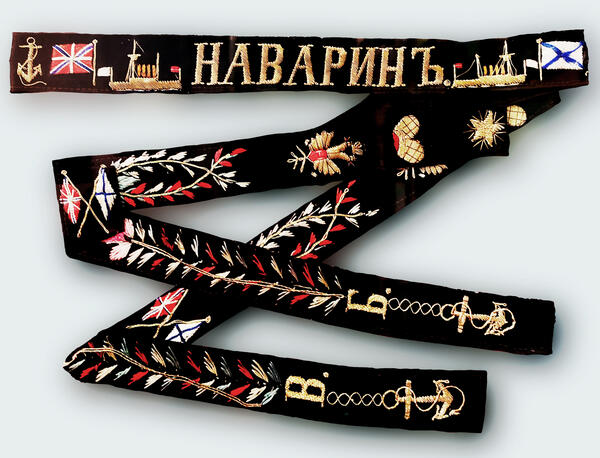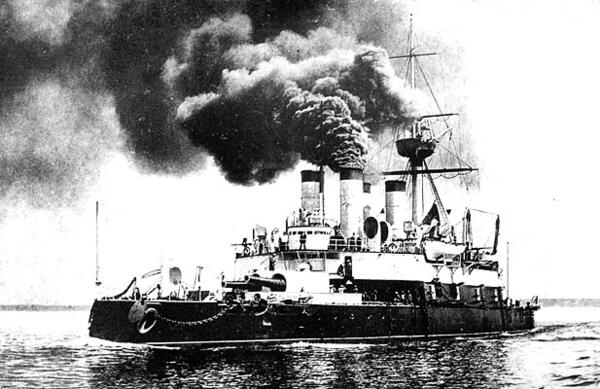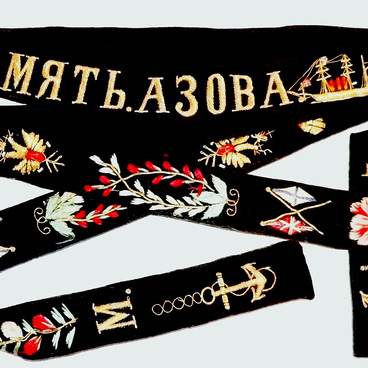Ribbon from the peakless cap of a sailor of the battleship Navárin. Sewn from black fabric, decorated with embroidery, colored threads.
Sailor's tape
Время создания
early 1990s
Место создания
Russia
Размер
206х3 cm
Техника
factory production
Коллекция
0
Открыть в приложении#1
Unknown author
Sailor ribbon
#2
#4
Squadron battleship ‘Navárin’. Author: unknown - Internet, Public Domain, https://ru.wikipedia.org/w/index.php?curid=1451610
#3
The squadron battleship Navárin is a towered, citadel Russian battleship built at the end of the 19th century. It was launched in 1891, but it only entered into use after five years — during tests it turned out that the ship’s machines had not developed their contractual capacity, and questions were also raised about its unsinkability. After revision, it became a successful model, and the technical solutions of the Navárin have found application in several subsequent projects. The ship was actively used; it was constantly deployed in the Russian fleet formations of the Mediterranean Sea and in the Far East. It went down in the Battle of Tsushíma on May 15, 1905.
In the history of the Navy, the first mention of black ribbons dates back to 1805, when British officers, as a sign of mourning for Admiral Nelson, tied black crepe ribbons on the crowns of their hats.
In the Russian Navy, the first ribbons appeared on the oilcloth hats of sailors in 1857, and on caps no later than 1872. Until that time, only slotted letters and numbers were placed on the rims of sailor’s caps, which were painted over or lined with yellow cloth. The ribbon was supposed to have the name of the naval crew, the name of the ship, and sometimes the image of an anchor.
In the 1870s, a black peakless cap with a ribbon was introduced in the Russian fleet, on which the name of the naval crew or ship was indicated. The exact size, shape of the letters on the ribbons, as well as the ribbons themselves, were approved for the entire rank and file of the Russian fleet in 1874. The exact length of the ribbon was also specified: 140 cm.
From 1921-1923, during the Soviet Union, a new cap was adopted which is still in effect. The length of the ribbon was reduced, as well as a new cubic font, and instead of the name of the ship, since 1949 only the name of the fleet was included for reasons of secrecy. An exception was made only for the cruiser Aurora and the names of naval schools. Later, in the 1980s, the general inscription ‘Navy’ was applied to the ribbon.
Now, the tradition of putting the name of the ship on the ribbons is returning, as it emphasizes the uniqueness of the duty station, and not just belonging to a particular fleet. A peakless cap with a ribbon has become one of the main symbols of the Russian fleet. It is often worn, and not only on special occasions
In the history of the Navy, the first mention of black ribbons dates back to 1805, when British officers, as a sign of mourning for Admiral Nelson, tied black crepe ribbons on the crowns of their hats.
In the Russian Navy, the first ribbons appeared on the oilcloth hats of sailors in 1857, and on caps no later than 1872. Until that time, only slotted letters and numbers were placed on the rims of sailor’s caps, which were painted over or lined with yellow cloth. The ribbon was supposed to have the name of the naval crew, the name of the ship, and sometimes the image of an anchor.
In the 1870s, a black peakless cap with a ribbon was introduced in the Russian fleet, on which the name of the naval crew or ship was indicated. The exact size, shape of the letters on the ribbons, as well as the ribbons themselves, were approved for the entire rank and file of the Russian fleet in 1874. The exact length of the ribbon was also specified: 140 cm.
From 1921-1923, during the Soviet Union, a new cap was adopted which is still in effect. The length of the ribbon was reduced, as well as a new cubic font, and instead of the name of the ship, since 1949 only the name of the fleet was included for reasons of secrecy. An exception was made only for the cruiser Aurora and the names of naval schools. Later, in the 1980s, the general inscription ‘Navy’ was applied to the ribbon.
Now, the tradition of putting the name of the ship on the ribbons is returning, as it emphasizes the uniqueness of the duty station, and not just belonging to a particular fleet. A peakless cap with a ribbon has become one of the main symbols of the Russian fleet. It is often worn, and not only on special occasions
#5
MUK ”Kótlas Museum of Local Lore”
читать дальшескрыть
00:00
00:00
1x
Sailor's tape
Время создания
early 1990s
Место создания
Russia
Размер
206х3 cm
Техника
factory production
Коллекция
0
Открыть в приложении
Поделиться




